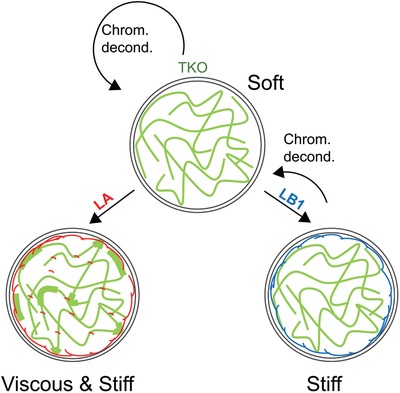Figure 5.

A simplified viscoelastic model of the nucleus: This simplified model captures only the dominant viscoelastic contributions of lamins and chromatin. Top: TKO nuclei (top) that lack all lamins and consist mainly of decondensed chromatin are soft (k ST = 150 Pa) similar to mES and iPS nuclei and flow with relatively low viscosity ( μM = 2300 Pa s). Expression of lamin‐A or lamin‐B1 stiffen the nucleus whereas chromatin decondensation softens the nucleus in cells that lack lamin‐A (right). Lamin‐B1 contributes only to steady state stiffness k ST and not to instantaneous stiffness k M. Left: Nucleus viscosity μM is dominated by lamin‐A (rescue of 30% lamin‐A WT levels leads to ≈3.5‐fold increase in μM). Chromatin decondensation also increases viscosity of lamin‐A expressing nuclei. Coexpression of lamin‐A and lamin‐B1 increases both nucleus elasticity and viscosity and stabilizes chromatin condensation.
